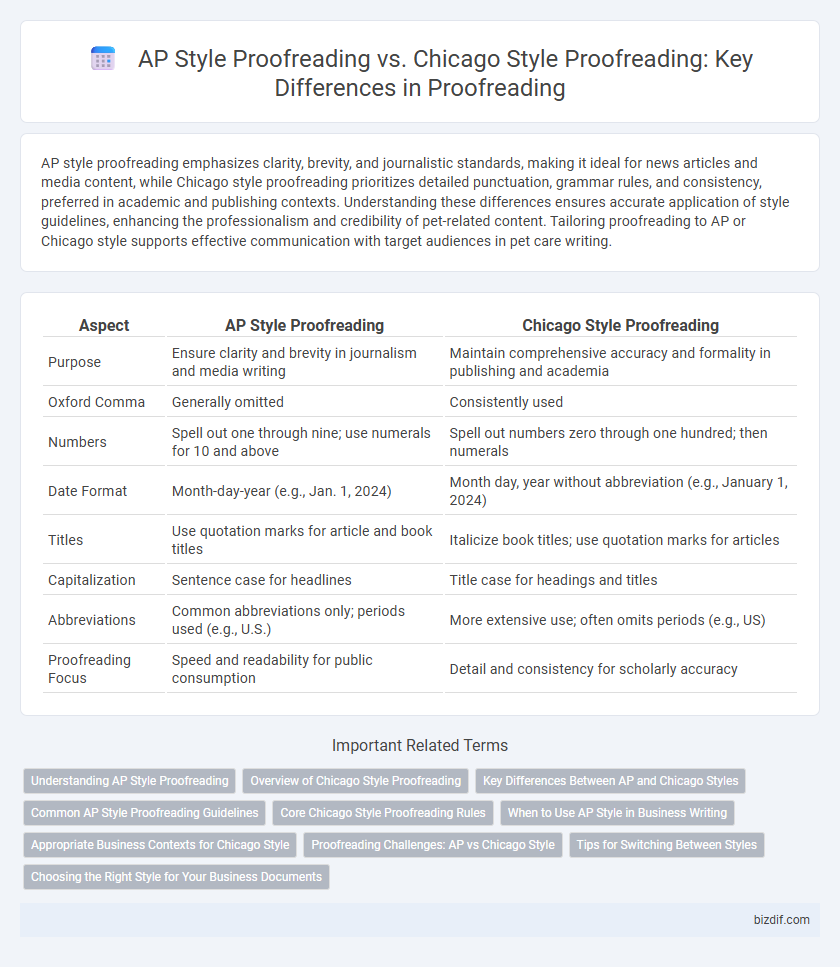AP style proofreading emphasizes clarity, brevity, and journalistic standards, making it ideal for news articles and media content, while Chicago style proofreading prioritizes detailed punctuation, grammar rules, and consistency, preferred in academic and publishing contexts. Understanding these differences ensures accurate application of style guidelines, enhancing the professionalism and credibility of pet-related content. Tailoring proofreading to AP or Chicago style supports effective communication with target audiences in pet care writing.
Table of Comparison
| Aspect | AP Style Proofreading | Chicago Style Proofreading |
|---|---|---|
| Purpose | Ensure clarity and brevity in journalism and media writing | Maintain comprehensive accuracy and formality in publishing and academia |
| Oxford Comma | Generally omitted | Consistently used |
| Numbers | Spell out one through nine; use numerals for 10 and above | Spell out numbers zero through one hundred; then numerals |
| Date Format | Month-day-year (e.g., Jan. 1, 2024) | Month day, year without abbreviation (e.g., January 1, 2024) |
| Titles | Use quotation marks for article and book titles | Italicize book titles; use quotation marks for articles |
| Capitalization | Sentence case for headlines | Title case for headings and titles |
| Abbreviations | Common abbreviations only; periods used (e.g., U.S.) | More extensive use; often omits periods (e.g., US) |
| Proofreading Focus | Speed and readability for public consumption | Detail and consistency for scholarly accuracy |
Understanding AP Style Proofreading
Understanding AP Style proofreading involves focusing on clarity, brevity, and consistency to meet journalistic standards. AP style emphasizes concise language, abbreviations for common terms, and specific rules for numbers, dates, and titles. Mastery of AP style ensures accurate communication tailored for news writing and immediate public consumption.
Overview of Chicago Style Proofreading
Chicago Style proofreading emphasizes consistency in punctuation, citation, and formatting, guided by The Chicago Manual of Style, widely used in publishing and academia. It prioritizes detailed attention to grammar rules, proper use of commas, quotation marks, and footnotes or endnotes for source documentation. This style also requires careful verification of bibliography accuracy and alignment with Chicago's standards to ensure clarity and professionalism in manuscripts.
Key Differences Between AP and Chicago Styles
AP style proofreading emphasizes concise language, straightforward punctuation, and timely news reporting conventions, using minimal Oxford commas and focusing on clarity for journalism. Chicago style proofreading allows for more nuanced grammar rules, including the use of Oxford commas and detailed citation formats, catering to academic and book publishing needs. Key differences include abbreviation guidelines, number formatting, and title capitalization rules, reflecting their distinct target audiences and purposes.
Common AP Style Proofreading Guidelines
AP style proofreading emphasizes clarity, brevity, and consistency in language, favoring the use of numerals for ages, times, and percentages, while Chicago style allows more flexibility with such elements. Common AP style guidelines include using commas only before conjunctions in lists, spelling out months when used alone or with a year, and capitalizing formal titles only when they precede a name. These rules streamline news writing, ensuring factual precision and reader accessibility across various media platforms.
Core Chicago Style Proofreading Rules
Core Chicago Style proofreading rules emphasize consistent use of serial commas, precise attribution of quotations, and clear formatting for titles and numbers, adhering strictly to the Chicago Manual of Style guidelines. Unlike AP style, Chicago style allows for Oxford commas to improve clarity in complex lists and prefers spelling out numbers below 101 or round numbers for readability. Proofreaders must also verify proper use of hyphens, en dashes, and em dashes as specified by Chicago standards to maintain professional and polished text presentation.
When to Use AP Style in Business Writing
AP style proofreading is essential in business writing for clear, concise communication in journalism, corporate reports, and press releases where consistent grammar and punctuation enhance readability. It is preferred when targeting a broad audience, ensuring accessible language and standardized abbreviations that comply with media industry norms. Using AP style in business writing improves professionalism and maintains uniformity across external communications.
Appropriate Business Contexts for Chicago Style
Chicago style proofreading is ideal for academic publishing, non-fiction books, and formal business documents that require detailed citations and a comprehensive bibliography. It is preferred in industries like publishing, education, and legal fields where precise source attribution and formal tone are essential. Businesses producing in-depth reports, research papers, or policy documents benefit from Chicago style's allowance for extensive notes and clear, standardized formatting.
Proofreading Challenges: AP vs Chicago Style
AP style proofreading demands strict adherence to concise language, emphasizing brevity and clarity, which often requires careful attention to punctuation and capitalization nuances unique to journalistic writing. Chicago style proofreading involves a more detailed focus on comprehensive grammar rules, complex citation formats, and the consistent application of the Oxford comma, challenging proofreaders to maintain consistency in long-form content. Both styles require specialized knowledge, but AP style prioritizes speed and clarity for news media, whereas Chicago style emphasizes thoroughness and academic precision.
Tips for Switching Between Styles
When switching between AP style proofreading and Chicago style proofreading, closely monitor differences in punctuation, such as the use of the serial comma, which AP style omits while Chicago style includes. Adjust grammar checks to align with each style's preferences on date formats, numeral usage, and headline capitalization. Utilize dedicated style guides and consistency tools to ensure thorough adherence and minimize errors during the transition.
Choosing the Right Style for Your Business Documents
Selecting the appropriate proofreading style for your business documents hinges on the intended audience and industry standards. AP style proofreading, favored in journalism and public relations, emphasizes brevity and clarity, while Chicago style proofreading suits academic and book publishing with its detailed punctuation and citation rules. Aligning your proofreading approach with your business's communication goals ensures consistency and professionalism in your written materials.
AP style proofreading vs Chicago style proofreading Infographic

 bizdif.com
bizdif.com